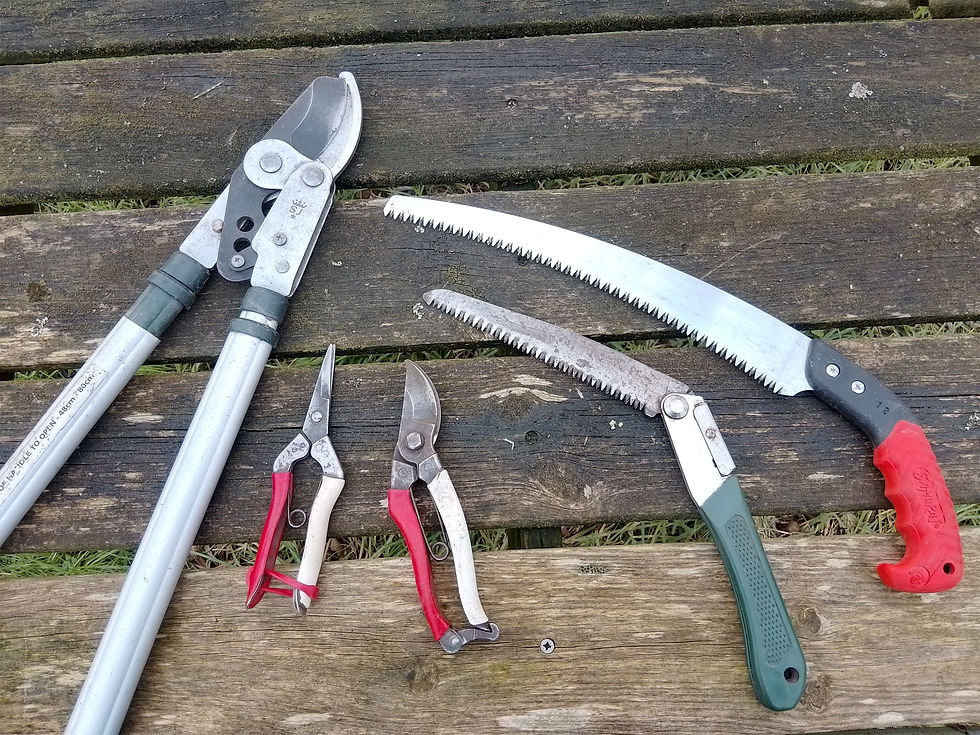Plant Spotlight - The Snowdrop
- Nancy Lowe

- Jan 30, 2024
- 4 min read
In the unfolding drama of the British wildflower year, the subtle beauty of the Snowdrop is the star that kicks off the show. Right now, in late Winter, they’re a glorious sight in woodlands up and down the country – magnificent in their carpeting drifts of crisp white, yet each individual flower, a perfect drop of beauty in its own right. How do we capture a piece of this wild wonder for our own gardens, so we can enjoy this natural spectacle at home?
Growing Snowdrops can be very easy, if planned out with care. Beware though, that in some instances, the very quality that makes them so beautiful in a woodland setting can create a gardening headache. Snowdrops – especially the more wildlife friendly ‘single’ varieties – do have a tendency to set seed and take over. If tidy beds, with low-growing specimen plants are a key part of your garden’s charm, you will want to think carefully before unleashing this dainty, but powerful plant. It will spread, it will grow through other plants, its leaves – best left to die back naturally – will potentially smother out emerging Spring plants and in an other-wise tidy scheme, will look rather scruffy until mid Spring. While not necessarily a pressing concern for every gardener, this problem is nevertheless easy to avoid with a little forward planning. There are three perfect gardening scenarios in which the Snowdrop can be enjoyed in all its glory and with very little effort by us gardeners.

POOLS OF WHITE - SHRUBBERY COMPANIONS
If we think back to the natural wonder that is those carpets of woodland white, this is what we ideally want to achieve with the garden Snowdrop, to really gain the wow factor that this plant is so perfect at producing. The first way we can get this effect in our garden is to grow Snowdrops as an understorey plant in a border mainly filled with shrubs and trees. In late winter, these types of beds can look rather drab and uninteresting, particularly around deciduous shrubs with their bare branches. Allowing Snowdrops to fill the ground under these plants will perfectly mimic those winter woods, creating a show during an otherwise rather dull time of year for the garden. Later, as the flowers die and their leaves become straggly and rather sorry looking, blossoming shrubs can steal the show, drawing the eye up and away, hiding the ground level die-back through a simple act of distraction.
TOP TIPS
Position initial plants directly beneath deciduous (Autumn leaf-dropping) shrubs. The pool of white centred around the base of shrubs will create a beautiful, naturalistic look.
For year-round beauty, include Spring flowering shrubs to distract from Snowdrop die-back, along with a suitable range of other shrubs to also provide Summer and Autumn colour. Evergreen shrubs are also great to include and will provide a good, solid backdrop to your Snowdrops at the time of flowering.
To grow Snowdrops in shrub bed that also includes perennial plants, two particular types of perennial plant will cope with the inevitable spread of Snowdrops. Summer flowering herbaceous perennials, such as Bleeding Heart (Dicentra), japanese anemone and the many varieties of Daisy (Aster) will still be dormant or extremely small while Snowdrops are flowering, so both can happily inhabit the same space. Perennial plants with a strong, evergreen presence will stand proudly up and above any wayward Snowdrops without any problem. Hellebores, Gladwyn Iris (Iris foetidissima) and Turkish Sage (Phlomis russeliana) are all good choices.

GRASSLAND BEAUTY
The second easy method for creating a show with Snowdrops in your garden, is simply to grow them through your grass. This will work in any shady and / or moist garden grass and works particularly well from an aesthetic point of view if set up in the grass around hedges or garden trees. Snowdrops grow through grassland in the wild - a favourite spot of mine are those pictured above, growing on the south face of a local ancient castle mound here in the Shropshire Hills. They are perfectly adapted to this type of habitat, disappearing from view during the long grass season, emerging while grasses are at their weakest and at a time when no mowing is needed, during winter. They will grow and spread in a sunny spot, despite their woodland reputation. However they will do so most successfully if the soil here remains moist (at bulb depth of a round 4-6cm / 2-3 inches) and if this area is in shade for part of the day in Summer at least.
TOP TIPS
For a naturalistic look, plant initially close to tall features, such as trees, shrubs or even artificial structures, such as fences, pergolas or washing lines.
Avoid mowing until leaves have begun yellowing, for a strong show of flowers year after year. After flowering, the leaves will use the rest of the Spring to produce food, which will be stored underground in the bulbs throughout their dormant season in Summer and Autumn, ready to push up strong flowering stems again the following Winter.

POTTED BEAUTY
The last easy way to grow and enjoy Snowdrops in the garden takes advantage of that second star quality of these plants – the simple beauty of the individual plants themselves. For this, it’s hard to resist growing an individual clump close to the house. A Snowdrop pot outside the entrance, on a patio or doorstep, is the perfect spot from which their subtle charm can be enjoyed.
TOP TIPS
Choose a style of pot that really shows of their subtle beauty – something with a simple, uncomplicated design works well, as do dark or natural colours, reminiscent of the forest floor. Black, blue and classic terracotta are all good choices.
Snowdrop bulbs like to keep moist when dormant. Hide your pot in a cool, shady spot during the Summer months.







Comments